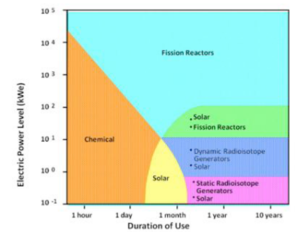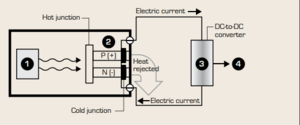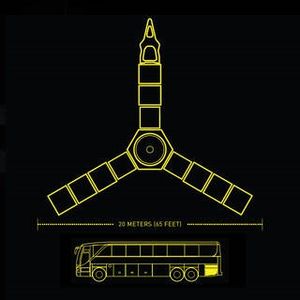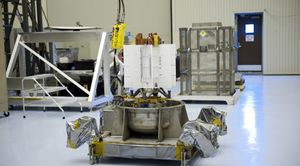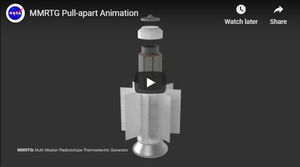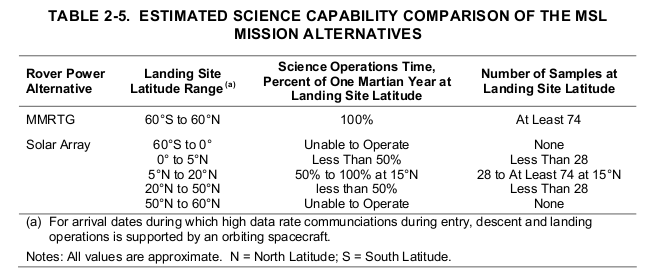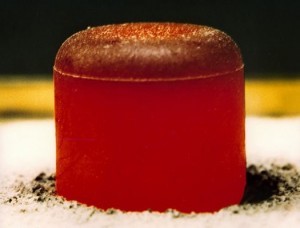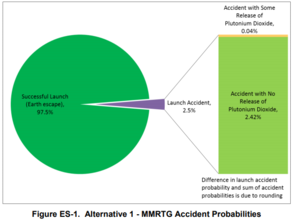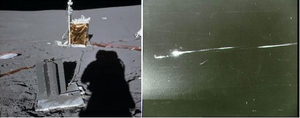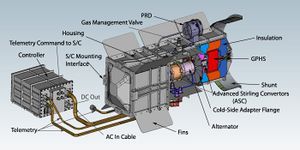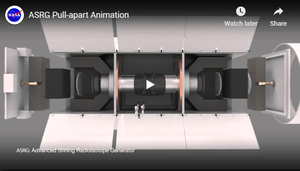Radioisotope Thermoelectric Generators: Advantages and Disadvantages
Spacecraft have three main options for power generation: chemical, solar, and nuclear. To the general public, the last of these sources may conjure images of reactors using fission processes, and many probes (particularly those launched by Russia[1]) have successfully employed such systems. Most nuclear-powered probes traveling beyond Earth orbit, however, have instead utilized radioisotope thermoelectric generators (RTGs), which harness the heat produced by radioactive decay rather than a nuclear chain reaction. RTGs offer an alternative to the more typical solar power when conducting missions where sunlight is scarce, as occurs when traveling to the outer solar system or the dusty atmosphere of Mars.
Contents
How RTGs Work
Although RTGs use radioactive fuel to generate electricity, they should not be confused with nuclear reactors. The latter harness the energy produced by controlled fission or fusion processes, but no chain reaction takes place in RTGs.
Instead, unstable radioactive materials known as radioisotopes produce heat as a by-product of their radioactive decay as emitted particles transfer their energy into surrounding atoms.[2] This decay takes place within a shell of semiconductors which generates an electric current when each end is exposed to differing temperatures due to the thermoelectric effect. Simply put, charge carriers diffuse away from a heat source and build up at the cold end of a material; in semiconductors, these charge carriers can be electrons (“n-type semiconductors”) or electron holes (i.e. a position where an electron could exist; these semiconductors are called “p-type”). By connecting n-type and p-type semiconductors with a metallic strip, electrons flow between the two once heat is applied, generating an electric current. This connection of n- and p-type semiconductors is called a thermocouple.[3][4]
In RTGs, the thermocouple’s heat source comes from the radioactive decay of the RTG’s fuel source heating the interior of its thermoelectric shell, while the exterior is kept cool by the surrounding atmosphere or vacuum. As long as a constant temperature gradient is maintained, electricity will be produced.[1][5][6][7]
Previous Missions Utilizing RTGs
Beginning with the navigational satellite Transit 4A in 1961, RTGs have long served as power sources in spacecraft.[1] Successful missions include the following:[6][8][9][10]
- Earth orbit: the Transit program, Nimbus III, LES 8 & 9, Russian Cosmos navigation satellites
- Lunar surface: China’s Chang’e landers; Apollos 12 and 14-17 successfully deployed RTGs to power their Lunar Surface Experiments Package (ALSEP)
- Interplanetary: Pioneer 10 & 11, Voyager 1 & 2, Galileo, Ulysses, Cassini, New Horizons
- Martian surface: Viking 1 & 2, Curiosity
Future missions such as Mars 2020 and ExoMars are also scheduled to employ RTGs as power sources.[7][11]
Other missions such as the Mars Exploration Rovers (MERs) Spirit and Opportunity have employed radioactive heater units (RHUs) which are similarly based on the decay or radioisotopes. As their name implies, however, RHUs are used for heating rather than power generation; for this, both MERs relied on solar arrays.[7]
Advantages of RTGs
Problems with solar
While solar arrays have traditionally been the most popular choice for spacecraft traveling within the inner solar system, solar intensity decreases according to the inverse-square law.[1] That is, a craft twice as far from the sun will only receive one quarter the solar energy: around Earth, 1,374 Watts/m² are available from sunlight, but this falls to 50 Watts/m² near Jupiter, and 1 Watt/m² at Pluto.[9] This means that the farther from the sun a solar-powered spacecraft travels, the larger the solar panels it must carry.
The Juno mission to Jupiter, for example, holds the record as having traveled the farthest from the sun while sustained by solar power.[12] In order to accomplish this feat, it is equipped with three 2.7 by 8.9 meter (8.9 by 29.2 feet) solar arrays;[1][13] fully extended, these arrays cover roughly the size of a regulation basketball court. The arrays themselves total 340 kg (750 lbs), over three times the weight of an RTG system.[14]
While advances in photovoltaic technology may allow for solar-powered probes to function as far out as Saturn in the near future,[15] the required increases in probe size and mass will correspondingly add to the cost of launch.
Indeed, an all-solar configuration was considered for the Cassini mission to Saturn.[16] Sporting four solar arrays, each five times larger than those of the Hubble Space Telescope, this design increased the spacecraft’s dry mass by 1,337 kg (2,948 lbs) and would have exceeded the maximum launch capacity of the Titan IV (SMRU)/Centaur by almost a ton. The weight of the panels on another proposed design for the mission greatly increased the spacecraft’s moment of inertia and thereby the difficulty of turning and maneuvering the probe. This would have significantly limited the mission’s scientific output due to factors such as reduced target tracking capability leading to lower image quality, and a loss of observation time while rotating to communicate with Earth.
In addition to the design challenges which face solar-powered systems, complications may arise over the course of their mission: fragile solar arrays are vulnerable to debris, particularly as size increases, and no sunlight will be available while on the far side of a planetary body.
This latter consideration is particularly relevant for rovers and landers who may need to spend long periods of time in obscured regions.[1] Notably, ESA’s Rosetta mission successfully landed a probe on the comet 67P/Churymov–Gerasimenko in 2014, but it bounced into the shadow of a cliff where its solar panels were unable to generate additional charge. The lander’s on-board batteries were only able to sustain it for 64 hours, a much shorter time period than the anticipated mission duration.[7]
Similar complications can arise from atmospheric conditions which reduce the amount of sunlight available. Although both rovers of the solar-powered MERs program long outlived their target three month lifespan, they were both dependent on small dust devils clearing dust accumulations off of their solar panels.[17] These chance-reliant 'cleaning events' risk dangerously low levels of power generation. For example, a global dust storm at one point left the Spirit rover with only 25% of its solar arrays dust-free.[18]
Benefits of RTGs
Because RTGs do not rely on energy from sunlight, they do not suffer the disadvantages posed by the location-dependent operation and large size of solar arrays. No matter their distance from or orientation to the sun, RTGs will continue to produce electricity as long as the radioisotope remains active.
The lifetime of an RTG is therefore limited only by the half-life of the fuel source, with power output shrinking by a small fraction each year as a consequence of radioactive decay. NASA's Multi-Mission Radioisotope Thermoelectric Generator (MMRTG), for example, has a minimum guaranteed lifetime of 14 years.[19] On the other hand, by powering down an ever-increasing number of instruments, NASA engineers have stretched the operation of Voyagers 1 and 2—launched in 1977—for almost half a century. They expect the spacecrafts’ Multihundred-Watt RTGs (MHW-RTGs) to provide sufficient power for at least one scientific instrument through 2025, and data could potentially continue to be returned through 2036.[20]
Further longevity is provided by the fact that RTGs are self-heating and have no moving parts, which helps them survive the harsh conditions of space and planetary surfaces with a relatively small level of risk.[1][7][9]
All of these factors played a role in the selection of RTGs for the Curiosity and Perseverance rovers. For both rovers, solar-powered alternatives were considered, but these would have placed substantial limitations on rover operations in terms of accessible latitudes, percentage of the year during which the rover could operate, and total mission lifetime.[11] For full effectiveness, the solar-powered variants would have been confined to a narrow band of latitudes near the equator which receive the necessary sunlight year-round and where panels could remain relatively free from dust. The variant powered by the MMRTG, on the other hand, could operate equally well across a wide range of latitudes.
Because the design of Perseverance was based so closely on the RTG-powered Curiosity, switching to a solar variant faced an additional obstacle in that it would have necessitated substantial design changes—and therefore technical risk—from the proven heritage model. This would have included a small (<10 kg or 22 lb) mass increase chiefly from the solar array support equipment, a revamped thermal design to accommodate electrically-generated heating rather than using that coming from the MMRTG's thermal energy, and potential changes in the accommodation for the mission’s scientific instruments.[18] The RTG alternative was therefore retained for Perseverance as well.
Disadvantages
Environmental Risks of RTGs
Potential risks
RTGs are not, however, without their drawbacks. Given their use of radioactive material, they obviously pose environmental risks that solar panels do not. The most commonly-used radioisotope in RTGs, Plutonium-238 (238Pu), is relatively safe in comparison to alternatives. The radiation emitted by the decay of 238Pu primarily takes the form of alpha particles, which can be blocked with a thin sheet of paper or even the outer layer of one’s skin.[1][7][21] In addition to reducing mass requirements in terms of heavy shielding for humans or spacecraft, this means that 238Pu poses little danger unless pulverized into particles fine enough to inhale. Should this occur, it would cause severe damage to internal organs, particularly the skeleton and liver.
In order to mitigate these risks in the event of a crash landing or failed launch, the 238Pu used in RTGs is combined with oxygen to create ceramic pellets of plutonium dioxide (PuO2). This substance forms a crystalline lattice which breaks into large chunks rather than fine, inhalable particles. It also has an incredibly high melting point, remaining solid at up to 2700°C, and is extremely insoluble in water should it splash down in an ocean.[10] This already sturdy substance is further reinforced with its own corrosion- and heat-resistant shielding in the form of iridium and high-strength graphite, followed by an aeroshell which protects against the heat of atmospheric reentry.[1] All of these factors combine to greatly reduce the risk of contamination in the case of a failed launch or crash landing.
Given the already low probability of a launch accident, the probability of one resulting in the release of radioactive material is even lower. The Environmental Impact Statement for the Mars 2020 rover, for example, quantifies this risk by stating that there is a 1 in 2,600 chance of a launch accident that would release PuO2; this includes accidents at launch, prior to reaching Earth orbit, and after reaching Earth orbit.
None of these three situations were predicted to induce near-term radiological fatalities, but the additional mean number of latent cancer casualties was anticipated to increase by 0.29, 0.20, and 0.0026, respectively. To contextualize these numbers, the report states, “The average maximum dose to any member of the public from an accident with a release in the launch area would be equal to about 3 months of exposure to natural background radiation for a person living in the United States.”
Despite the improbability of radiological fatalities due to the launch of the rover, it should be noted that this number would drop to 0 in the proposed solar-powered variant.

Previous accidents
While the anticipated risk of launch accidents is low and any radiation-related fatalities even lower, the fact remains that numerous accidents have occurred involving RTGs.[1]

Some of these have released radioactive material high in the Earth’s atmosphere, as occurred when the 1964 US Transit 5BN-3 mission failed to achieve orbit and entered the record as the first nuclear accident in space. In 1978, the USSR Cosmos 954 scattered around 50 kg of uranium-235 over northern Canada after unintentionally reentering the atmosphere. Fortunately, the area’s low population density meant that only a small number of residents were exposed to radiation, and none of those were seriously harmed.
Other accidents have deposited radioactive material into the ocean. The US Nimbus B-1 was destroyed shortly after launch in 1968 as part of a necessary abort protocol, dumping the RTG into the Santa Barbara Channel off the coast of California. The RTG was recovered five months later and found to be intact, indicating that no radioactive contamination had occurred.[1][10]
In 1983, the USSR Cosmos 1402 satellite reached the end of its operational period. At this stage, nuclear cores are typically ejected into an orbit above the Earth which is much higher (and therefore safer, although it remains theoretically possible that a collision between nuclear debris in these graveyard orbits could bring them back down to Earth). In this case, however, the planned separation did not occur, and the reactor splashed down with the rest of the spacecraft somewhere in the South Atlantic Ocean.[1]
A similar unplanned ocean reentry occurred in the famed case of Apollo 13. Each of the Apollo missions following the first landing on the moon carried with them an RTG as part of the ALSEP program. These RTGs were to be left on the lunar surface to power a series of science instruments, but in the case of Apollo 13, the mission was aborted before any landing was attempted. Instead, the lander was brought back with the crew to Earth, serving as a life raft after the service module was damaged. The astronauts returned to Earth safely in Apollo 13’s command module, but their RTG crash landed along with the lunar module in the Pacific Ocean’s Tonga Trench. It is estimated that the RTG’s 3.9 kg of PuO2 will remain radioactive for two millenia, although water testing has indicated that no contamination has occurred as a result of the heat shield rupturing on reentry.[1][6]
While RTGs are designed to prevent accidental contamination through pulverization, a 1970 account demonstrates that keeping the radioactive source concentrated in one large chunk does not completely protect humans from danger. In this case, after the explosion of a rocket near the Baikonur cosmodrome, investigators searching for a nuclear battery found it in the possession of Soviet soldiers—the guards had found it in the wreckage and had kept it as a hand-warmer. The report does not detail whether the soldiers suffered any adverse effects, but such an anecdote illustrates yet another way in which failed launches can potentially endanger the populace.[1]
Lack of Plutonium
The environmental drawbacks of RTGs are arguably minor in comparison to the issue of limited supply. After the discovery of 238Pu in the 1940s, more than 20 kg (45 lbs) per year were produced throughout the Cold War as a byproduct of the production of nuclear weapons.[1][10][23] With the rise of nuclear non-proliferation, however, production halted and the US has since primarily relied on supplementing its remaining stocks with purchases from Russia.
Production resumed in limited quantities in 2013, with the hope of producing up to 1.5 kilograms (3.3 pounds) per year by the early 2020s. This amount would be far less than Cold War levels, but could still help supplement decaying stockpiles.[10] As of 2014, NASA had only 35 kilograms (77 pounds) of 238Pu available, with roughly half of that quantity having decayed to the point where it no longer met minimum energy requirements for new missions.[1][5][23]
Historically, somewhere between 3 to 11 kilograms (7-24 pounds) of 238Pu have been used per RTG-powered mission. This means that NASA only has enough for 2-3 more missions using current technology.[1][5][10][23] One of these is already committed to the Perseverance rover, which will launch to Mars with an RTG in 2020.[5][23] The upcoming Dragonfly mission to Titan also calls for an RTG of the same style, although it leaves open the possibility of other radioisotope alternatives.[24]
Future Developments in RTG Technology
ASRG
One of the most promising future technologies which could potentially replace the MMRTG powering NASA’s current missions is the Advanced Stirling Radioisotope Generator (ASRG). First created in 1816, the conventional Stirling engine has served a variety of purposes, from wood-fired stove fans to battery chargers on nuclear submarines.[25] The engine uses a small amount of gas (also called a ‘working fluid’) contained within a fixed area which is heated on one end and cooled on the other. Two separate, reciprocating pistons help direct the movement of the working fluid and harness the energy from its expansion to perform mechanical work.[26]
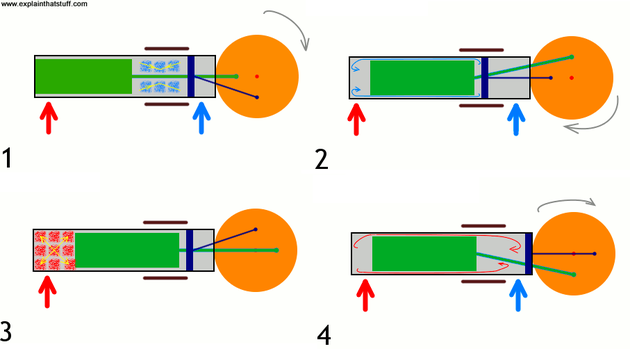
Like conventional RTGs, the ASRG would use the heat produced by the decay of a radioisotope along with the cool surrounding environment to form the temperature differential for its Stirling engine. But rather than producing current across thermoelectric couples, the ASRG uses the heat source to move a magnetized piston through a coil of wire.[27] The benefit of this alternative is that it is far more efficient: the MMRTG used on Curiosity and Perseverance only converts around 8% of its heat energy into electricity.[1] The ASRG design, however, would outperform the MMRTG by a factor of four, meaning only one quarter of the amount of 238Pu would have to be included to generate the same amount of power.[1][5][28]
The principal downside of the ASRG design is that this efficiency comes at the cost of moving parts, sacrificing the long-term reliability of the solid-state MMRTG. Furthermore, the vibrations induced by the ASRG could have negative repercussions for sensitive scientific instruments attached to the spacecraft.[1] Finally, the loss of the excess heat produced by the MMRTG might necessitate the inclusion of an alternative heating system, thereby increasing complexity and mass.[27]
In order to ameliorate concerns about longevity, one could use helium as the working fluid to provide the function of a hydrostatic bearing and thereby prevent nearly all friction between the pistons and the cylinder walls—this approach is predicted to give an operational lifetime of 17 years. Two properly-aligned and synchronized sets of two-piston systems could also cancel out the majority of vibrations.[27]
A number of missions had proposed the use of the ASRG system, notable among them the canceled Titan Mare program.[29] After developing the ASRG design for over a decade, however, NASA canceled its production in 2013, citing a combination of budget constraints and the resumption of 238Pu production obviating the immediate need for more efficient RTGs.[30] According to Wikipedia, NASA maintains a small investment in the development of the technology through several private companies, but the most recent updates to these projects are listed as having occurred in 2016, so the present state of these projects is unknown.[28]
Alternative Isotopes
Another option for improving RTGs is changing the fuel source. 238Pu has historically been the most popular choice, but alternative radioisotopes exist. To be effective in RTGs, these alternatives must exhibit the following qualities:[1]
- Good power density, to account for low energy conversion efficiencies
- Long half-life, to provide useful power output over a long lifespan
- Low shielding requirements, for safety and to reduce interference with science instruments
- High power/mass ratio, to reduce total mission mass
238Pu meets all four of these requirements, while alternatives such as Strontium-90, Polonium-210 (used in older Russian RTGs), and Curium-242/244 fall short in one or more areas.[1]
The most promising alternative is Americium-241 (241Am). Favored by the European Space Agency[7] and currently used in smoke detectors and moisture gauges, 241Am is far more plentiful due to being a by-product of regular nuclear reactors rather than weapons-grade refineries.[1] It has a half-life of 432 years compared to 238Pu’s 88, making it superior in category 2 above.[7] On the other hand, it suffers in categories 1 and 3: it has roughly one quarter the power density of 238Pu (0.15 Watts per gram[7] vs. 0.56[1]) and emits high levels of gamma radiation, a more hazardous form of ionizing radiation than that produced by 238Pu. If, however, future RTGs can make efficiency gains offsetting 241Am’s reduced power density, it may come to be a more popular fuel source.[1]
References
- ↑ 1.00 1.01 1.02 1.03 1.04 1.05 1.06 1.07 1.08 1.09 1.10 1.11 1.12 1.13 1.14 1.15 1.16 1.17 1.18 1.19 1.20 1.21 1.22 1.23 1.24 Karacalıoğlu, G. (2014, January 16). Energy Resources for Space Missions –. Space Safety Magazine. http://www.spacesafetymagazine.com/aerospace-engineering/nuclear-propulsion/energy-resources-space-missions/
- ↑ Decay heat. (2020). In Wikipedia. https://en.wikipedia.org/w/index.php?title=Decay_heat&oldid=951406419
- ↑ Alfred. (2018, October 25). How Thermoelectric Generators Work. Applied Thermoelectric Solutions LLC. https://thermoelectricsolutions.com/how-thermoelectric-generators-work/
- ↑ James, L., & Granath, E. (2020, February 19). Understanding the difference between n- and p-type semiconductors. Power & Beyond. https://www.power-and-beyond.com/understanding-the-difference-between-n-and-p-type-semiconductors-a-905805/
- ↑ 5.0 5.1 5.2 5.3 5.4 U.S. Plutonium Stockpile Good for Two More Nuclear Batteries after Mars 2020. (n.d.). Retrieved April 19, 2020, from https://spacenews.com/u-s-plutonium-stockpile-good-for-two-more-nuclear-batteries-after-mars-2020/
- ↑ 6.0 6.1 6.2 Nerlich, S. (2010, October 9). Astronomy Without A Telescope—Solar Or RTG? Universe Today. https://www.universetoday.com/74755/astronomy-without-a-telescope-solar-or-rtg/
- ↑ 7.0 7.1 7.2 7.3 7.4 7.5 7.6 7.7 7.8 Nuclear Reactors for Space—World Nuclear Association. (2020, April). https://www.world-nuclear.org/information-library/non-power-nuclear-applications/transport/nuclear-reactors-for-space.aspx
- ↑
Robinson, David Gerald. Mars Science Laboratory Launch Risk Analysis Summary. United States. - ↑ 9.0 9.1 9.2 Allison, P. R. (2016, January 21). What will power tomorrow’s spacecraft? https://www.bbc.com/future/article/20160119-what-will-power-tomorrows-spacecraft
- ↑ 10.0 10.1 10.2 10.3 10.4 10.5 Siegel, E. (2018, December 13). NASA Doesn’t Have Enough Nuclear Fuel For Its Deep Space Missions. Forbes.Com. https://www.forbes.com/sites/startswithabang/2018/12/13/nasa-doesnt-have-enough-nuclear-fuel-for-its-deep-space-missions/#634152fe1c18
- ↑ 11.0 11.1 Leone, D. (2014, November 17). EPA Finds No Show-stoppers with Radioactive Battery for Mars 2020. SpaceNews.Com. https://spacenews.com/42588epa-finds-no-show-stoppers-with-radioactive-battery-for-mars-2020/
- ↑ News | NASA’s Juno Spacecraft Breaks Solar Power Distance Record. (2016, January 13). https://www.jpl.nasa.gov/news/news.php?feature=4818
- ↑ Juno Solar Panels Complete Testing. (2016, June 24). NASA. http://www.nasa.gov/mission_pages/juno/news/juno20110527.html
- ↑ Brakels, R. (2016, July 6). Why NASA Chose Solar Power Over Nuclear For The Juno Space Probe. Solar Quotes Blog. https://www.solarquotes.com.au/blog/nasa-chose-solar-power-nuclear-juno-space-probe/
- ↑ Benson, S. W. (2007, November 8). Solar for Outer Planets Study. Outer Planets Assessment Group.
- ↑ Cassini Final Environmental Impact Statement | NASA Solar System Exploration. (1997, September 24). https://solarsystem.nasa.gov/resources/17808/cassini-final-environmental-impact-statement/
- ↑ O’Neill, I. (2014, April 21). Opportunity: The Amazing Self-Cleaning Mars Rover (Photos). Space.Com. https://www.space.com/25577-mars-rover-opportunity-solar-panels-clean.html
- ↑ 18.0 18.1 Final Environmental Impact Statement for the Mars 2020 Mission. (2014). Retrieved from https://mars.nasa.gov/mars2020/files/mep/Mars2020_Final_EIS.pdf
- ↑ NASA. (2013). Multi-Mission Radioisotope Thermoelectric Generator (MMRTG) Fact Sheet.
- ↑ Voyager—Frequently Asked Questions. (n.d.). Retrieved April 19, 2020, from https://voyager.jpl.nasa.gov/frequently-asked-questions/
- ↑ Radiation Basics. (2014, November 12). [Overviews and Factsheets]. US EPA. https://www.epa.gov/radiation/radiation-basics
- ↑ 3-2-2-1 Settlement of Claim between Canada and the Union of Soviet Socialist Republics for Damage Caused by “Cosmos 954” (Released on April 2, 1981). (1981, April 2). https://www.jaxa.jp/library/space_law/chapter_3/3-2-2-1_e.html
- ↑ 23.0 23.1 23.2 23.3 Griggs, M. B. (2015, March 11). NASA Can Make 3 More Nuclear Batteries, And That’s It. Popular Science. https://www.popsci.com/nasa-can-make-3-more-nuclear-batteries-and-thats-it/
- ↑ Lorenz, R. D., Turtle, E. P., Barnes, J. W., Trainer, M. G., Adams, D. S., Hibbard, K. E., ... & Ravine, M. A. (2018). Dragonfly: A rotorcraft lander concept for scientific exploration at titan. Johns Hopkins APL Technical Digest, 34(3), 14.
- ↑ Modern Uses of Stirling Engines. (n.d.). American Stirling Company. Retrieved April 19, 2020, from https://www.stirlingengine.com/modern-uses/
- ↑ 26.0 26.1 Woodford, C. (2020, April 10). How do Stirling engines work? Explain That Stuff. http://www.explainthatstuff.com/how-stirling-engines-work.html
- ↑ 27.0 27.1 27.2 NASA. (2013). Advanced Stirling Radioisotope Generator (ASRG) Fact Sheet.
- ↑ 28.0 28.1 Advanced Stirling radioisotope generator. (2019). In Wikipedia. https://en.wikipedia.org/w/index.php?title=Advanced_Stirling_radioisotope_generator&oldid=925822564
- ↑ Titan Mare Explorer. (2020). In Wikipedia. https://en.wikipedia.org/w/index.php?title=Titan_Mare_Explorer&oldid=946374069
- ↑ Green, J. (2013, November 11). Important Changes in the NASA Planetary Science Division’s (PSD) Radioisotope Program | Planetary News. https://www.lpi.usra.edu/planetary_news/2013/11/15/important-changes-in-the-nasa-planetary-science-divisions-psd-radioisotope-program/
Author
volunteer for The Mars Society
It is licensed under Creative Commons BY-SA 3.0 and may be freely shared, but must include this attribution.
